Solar power has become an increasingly popular renewable energy source. As a result, many homeowners and businesses in Canada are considering installing solar panels to harness the sun’s power.
When harnessing the sun’s power through solar panels, understanding the average peak sun hours in different provinces across Canada is crucial.
The amount of sunlight a region receives directly impacts the efficiency and output of a solar power system.
Knowing your province’s average peak sun hours can help you make informed decisions. It helps a homeowner consider solar PV installation or a business looking to reduce energy costs and environmental impact. Canada’s vast size and diverse climate result in variations in the average amount of sunlight received throughout the country.
In this guide, we will explore what average peak sun hours are and how they are used to measure sunlight. Furthermore, we will delve into the amount of sunlight Canada receives, the ideal sun hours for solar panels, and how you can calculate the peak sun hours for your roof.
What Is an Average Peak Sun Hour?

An average peak sun hour refers to the number of hours in a day during which the intensity of sunlight is equal to or greater than 1,000 watts per square meter.
It represents the amount of direct or bright sunshine solar panels can harness effectively.
It is important to note that average peak solar hours are not the same as the total number of hours the sun is visible during the day.
They precisely measure the sunlight suitable for generating solar power in different Canadian cities.
There are some notable variations regarding average peak solar hours in different provinces and Canadian cities across Canada.
Let’s take a closer look at the peak sun hour data for a few provinces:
British Columbia
Known for its milder climate, British Columbia experiences many peak sun hours yearly.
The southern regions of the province, such as Vancouver and Victoria, receive an average of 1,200 to 1,600 peak solar hours per year. It makes British Columbia an ideal location for PV panel installations.
Alberta
Alberta also benefits from many ideal sun hours, particularly in its southern regions.
Calgary, for example, receives around 2,000 sun hours annually. With its abundant sunlight, Alberta presents a promising opportunity for solar power generation.
Ontario
Ontario experiences moderate high sun hours, averaging 1,400 to 1,800 hours yearly.
Despite having slightly fewer peak sun hours than British Columbia or Alberta, Ontario has a well-developed solar industry. It offers various incentives to promote PV panel installations.
Quebec
Quebec’s peak sun hour data varies across the province due to its size. The southern regions, such as Montreal, receive around 1,300 to 1,500 hours yearly.
However, the number of peak hours decreases as you move further north. Despite this, Quebec has made significant progress in promoting renewable energy, including solar power.
Nova Scotia
The average peak sun hours are slightly lower than in British Columbia, Canada. This province is on the Atlantic coast and receives around 1,100 to 1,400 peak sun hours annually. Despite having fewer peak hours, Nova Scotia has been actively promoting renewable energy. It includes solar energy to reduce reliance on fossil fuels and promote a sustainable future.
New Brunswick
Further east, in New Brunswick, the average peak sun hours range from 1,200 to 1,500 hours per year. This province, bordered by Quebec and Nova Scotia, also offers ample opportunities for PV panel installations.
With a commitment to renewable energy, New Brunswick residents and businesses can use the available sunlight to generate clean electricity.
It is important to note that the figures provided here are general estimates and can vary depending on specific locations within each province.
Local weather patterns, geographical features, and shading from surrounding buildings or trees can affect a property’s peak sun hours.
How are Peak Sun Hours Used to Measure Sunlight?

Understanding how peak sun hours measure sunlight is essential for accurately assessing the solar potential of a particular location.
Peak sun hours provide a standardized measurement that considers the intensity and duration of sunlight throughout the day.
Solar system designers and installers can make informed decisions regarding the size, capacity, and efficiency of PV panel installations by quantifying the available sunlight.
Data from various sources, including meteorological records and satellite observations, are analyzed to determine peak sun hours.
Consider factors such as latitude, longitude, elevation, and local weather patterns.
Experts can estimate a particular region’s average number of peak sun hours. They consider these variables, allowing for accurate solar system design and energy generation predictions.
Additionally, using peak sun hour data, solar power system designers and installers can determine a solar system’s optimal size and capacity for a given location.
How Many Hours of Sunlight Does Canada Get?
Due to its vast size and diverse climate, the sunlight received in Canada varies significantly.
Generally, southern regions receive more sunlight than northern regions. Canada gets between 1,000 to 2,500 hours of daylight annually, depending on the province.
This variation is essential when calculating a specific location’s potential solar energy generation.
What Are the Ideal Peak Sun Hours for Solar Panels?
The ideal peak sun hours for solar panels depend on various factors. Such factors include:
- the solar panels’ type and efficiency
- the solar array’s angle and orientation
- the region’s climate
More peak sun hours generally translate to a more efficient solar panel system. However, even in areas with lower peak sun hours, solar panels can still generate a significant amount of electricity.
It is crucial to note that solar panels can still produce electricity on cloudy days, albeit at a reduced efficiency compared to clear, sunny days.
How Can I Calculate the Peak Sun Hours for My Roof?

Calculating the peak sun hours for your roof requires some knowledge of your location and the specific characteristics of your property.
One approach is to use online tools or solar calculators that utilize historical weather data and geographical information to estimate your area’s average peak sun hours.
These tools consider factors such as latitude, longitude, tilt angle, and shading to provide a reasonably accurate estimation.
Additionally, consulting with a professional solar panel installer can help you determine the peak sun hours for your roof more accurately based on per square meter calculation.
They can assess your property, analyze shading issues, and consider any local climatic conditions that may affect the efficiency of your solar system.
Conclusion
Understanding average peak sun hours is vital when considering solar panel installation in Canada. The amount of sunlight a region receives directly impacts the efficiency and output of a solar system.
It allows you to estimate the potential solar energy generation and optimize the size and capacity of your solar system accordingly.
By considering your province’s average peak solar hours and calculating your roof’s specific peak sun hours, you can make informed decisions about your solar system installation’s size, capacity, and upfront cost.
Harnessing the sun’s power through solar panels helps reduce reliance on non-renewable energy sources. It contributes to a cleaner and more sustainable future.


Leave a Reply